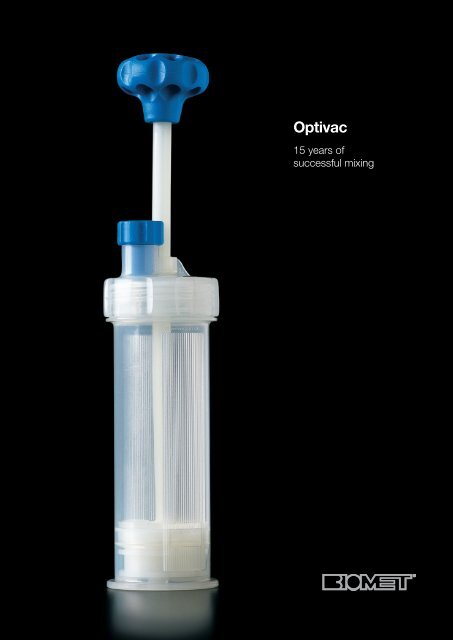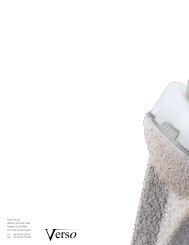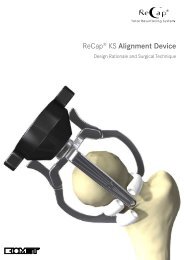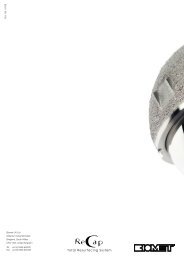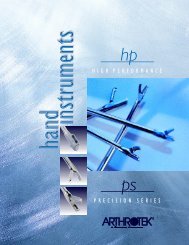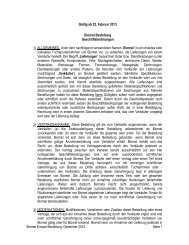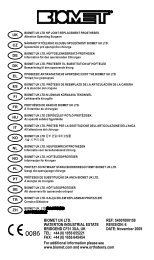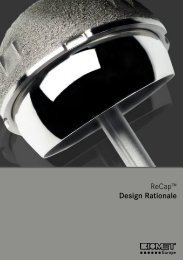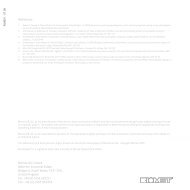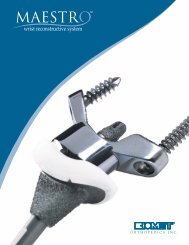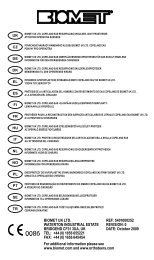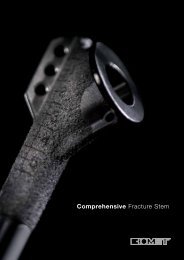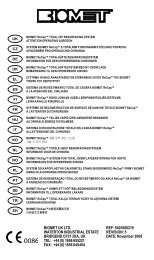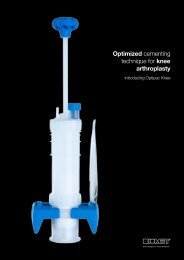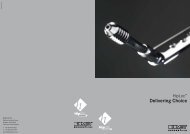You also want an ePaper? Increase the reach of your titles
YUMPU automatically turns print PDFs into web optimized ePapers that Google loves.
<strong>Optivac</strong><br />
15 years of<br />
successful mixing
Congratulations <strong>Optivac</strong>!<br />
Aseptic loosening due to porosity in bone<br />
cement has been a major problem since the<br />
start of cemented hip arthroplasty. The first<br />
experiments to reduce porosity in bone cement<br />
took place almost 25 years ago. This later led to<br />
the patented invention of bone cement collection<br />
under vacuum, which has been proven to<br />
eliminate macropores. In 1993, <strong>Optivac</strong> was<br />
introduced on the market and now celebrates<br />
15 years of successful mixing.<br />
<strong>Optivac</strong> is the world-leading vacuum mixing<br />
system and is a result of many years of<br />
continuous improvement.<br />
<strong>Optivac</strong> is unmatched in documentation<br />
among vacuum mixing systems. 1,2,3,4,5<br />
2 | O P T I V A C
The <strong>Optivac</strong> system is used in<br />
more than 45 countries worldwide<br />
Cement mixed under vacuum 7 Cement mixed at atmospheric pressure 7<br />
Improvement of bone cement quality<br />
Minimized porosity and improved<br />
mechanical strength<br />
Cement porosity directly affects the fatigue<br />
behavior of the bone cement. Reducing the<br />
number of pores can lead to remarkable<br />
improvements in cement strength and fatigue life.<br />
Several methods have been introduced in the<br />
interest of reducing cement porosity, the most<br />
efficient of which is applying vacuum throughout<br />
the mixing and collection of the cement. The<br />
fatigue life improves 10 times with vacuum mixing<br />
at 4º C compared to hand mixing. 6<br />
Improvement of bone cement quality by using a<br />
vacuum mixing system is one of the key pillars in<br />
Modern Cementing Technique.<br />
O P T I V A C | 3
Improvement of bone cement quality<br />
Mixing and collection under<br />
vacuum minimizes both<br />
macropores and micropores<br />
Comparison of vacuum mixing with<br />
or without collection 7<br />
Two types of pores are classified in fully<br />
polymerized bone cement:<br />
1) macropores, with a pore diameter of more<br />
than 1.0 mm.<br />
2) micropores, with a pore diameter of<br />
0.1–1 mm. 1,8<br />
Mixing under vacuum reduces the cement’s<br />
microporosity, but has less effect on macroporosity.<br />
Continuous vacuum – from mixing to<br />
collection – prevents macropore entrapment in<br />
high viscosity cement.<br />
With its patented design for collection<br />
under vacuum, <strong>Optivac</strong> reduces both<br />
microporosity and macroporosity. 1,5,4,2,9<br />
By dramatically reducing macroporosity,<br />
<strong>Optivac</strong> helps to prolong cement fatigue life.<br />
4 | O P T I V A C ®<br />
Bone cement<br />
mixed with a<br />
vacuum mixing<br />
system without<br />
collection under<br />
vacuum. High<br />
occurrence of<br />
macropores.<br />
Bone cement<br />
mixed with a<br />
vacuum mixing<br />
system with<br />
collection under<br />
vacuum.
Safe working environment<br />
<strong>Optivac</strong> meets modern safety standards and the<br />
high demands on mixing bone cement. Bone<br />
cement in <strong>Optivac</strong> is mixed and delivered in the<br />
same cartridge, precluding direct contact with the<br />
bone cement.<br />
The packing is PVC free and the blister pack<br />
also serves as a working tray, which minimizes<br />
the waste.<br />
<strong>Optivac</strong> contains no latex.<br />
By drawing monomer fumes through special<br />
filters, <strong>Optivac</strong> minimizes MMA exposures in<br />
the OR to barely detectable levels.<br />
Retrograde filling<br />
Optigun and Optigun Ratchet are used to deliver<br />
bone cement from the <strong>Optivac</strong> vacuum mixing<br />
system in a retrograde fashion. The guns are<br />
identical except for the feeding mechanism and<br />
rod. With the Optigun and Optigun Ratchet<br />
you will get adequate cement filling and the<br />
application under pressure will increase the<br />
cement’s interface strength and prevent air and<br />
blood inclusions in the cement mantle. 3,11<br />
The Swedish Arthroplasty Register has shown<br />
that retrograde cement filling of the femur<br />
reduces risk of revision and is an important step<br />
in Modern Cementing Technique. 10<br />
O P T I V A C | 5
Standardized procedure and a flexible system<br />
The <strong>Optivac</strong> standardized mixing procedure<br />
produces homogeneous cement with the lowest<br />
possible porosity.<br />
All types of bone cements can be mixed with the<br />
<strong>Optivac</strong> system. <strong>Optivac</strong> is adaptable to various<br />
application areas, such as hip, knee or shoulder<br />
arthroplasty. Suitable nozzles can be found in<br />
our assortment to be used for different types of<br />
application areas.<br />
Depending on the amount of the bone cement<br />
required, choose the suitable <strong>Optivac</strong> cartridge.<br />
Three sizes of <strong>Optivac</strong> cartridges are available,<br />
small, medium and large.<br />
Mixing is easy, requiring only a few simple steps.<br />
Illustrated step-by step instructions can be found<br />
on every product.<br />
<strong>Optivac</strong> was introduced in<br />
1993 and celebrates 15 years<br />
of successful mixing<br />
All sets include cartridge, nozzle, a vacuum line with sterile<br />
charcoal filter, a funnel, ampoule breakers and a working<br />
tray. The <strong>Optivac</strong> Hip and <strong>Optivac</strong> M sets also include<br />
a femoral pressurizer for optimal pressurization of the<br />
femoral canal.<br />
6 | O P T I V A C
Ordering information<br />
<strong>Optivac</strong> sets<br />
REF<br />
For low volume cements<br />
<strong>Optivac</strong> Hip Set ...................................... 4150<br />
<strong>Optivac</strong> S ............................................... 4161<br />
<strong>Optivac</strong> M .............................................. 4160<br />
<strong>Optivac</strong> L ............................................... 4152<br />
For high volume cements<br />
<strong>Optivac</strong> + Hip Set ................................... 4250<br />
Instrumentation<br />
REF<br />
Optigun .................................... 4193<br />
Optigun Ratchet...................................... 4195<br />
Vacuum pump ........................................ 4232<br />
Accessories<br />
REF<br />
Nozzle angled......................................... 4149<br />
<strong>Optivac</strong> Nozzle Knee............................... 4146<br />
Nozzle slim ............................................. 4154<br />
Nozzle revision ....................................... 4155<br />
Knee cementation nozzle ........................... 4312<br />
Nozzle cutter .......................................... 4159<br />
O P T I V A C | 7
References<br />
1 Wang J-S, Franzén H, Jonsson E, Lidgren L. Porosity of bone<br />
cement reduced by mixing and collecting under vacuum. Acta<br />
Orthop Scand 1993, 64 (2): 143-146.<br />
2 Wang J-S, Kjellson F. Bone Cement Porosity in Vacuum Mixing<br />
Systems, Bone Cements and Cementing Technique 2001,<br />
Walenkamp, Murray (Eds). Springer Verlag.<br />
3 Malchau H, Herberts P, Garellick G, Söderman P, Eisler T.<br />
Prognosis of Total Hip Replacement. Scientific Exhibition<br />
presented at the 69 the Annual meeting of the American Academy<br />
of Orthopaedic Surgeons. February 13-17, 2002, Dallas.<br />
4 Dunne N-J, Orr J.F. Influence of the mixing techniques on the<br />
physical properties of acrylic bone cement. Biomaterials 2001; 22:<br />
1819-1826.<br />
5 Wilkinson J.M., Stockely I, et al. Effect of mixing techniques on the<br />
Properties of Acrylic Bone-Cement, The Journal of Arthroplasty,<br />
2000; 15:663-667.<br />
6 Wang J-S, Toksvig-Larsen S, Muller-Wille P, Franzen H. Is there<br />
any difference between vacuum mixing systems in reducing bone<br />
cement porosity? Journal of Biomedical Materials Research. 1996;<br />
33: (2):115-8.<br />
7 Lidgren L, Bodelind B, Möller J. Bone cement improved by vacuum<br />
mixing and chilling, Acta Orthop Scand 1987; 57: 27-32.<br />
8 Lewis G. Properties of Acrylic Bone Cement: State of Art Review, J<br />
Biomed Mater Res. 1997; 38 (2): 155-82<br />
9 Breusch S, Cementing Techniques in Total Hip Replacement:<br />
Factors Influencing Survival of Femoral Components, In Bone<br />
cements and Cementing technique ed by Walenkamp G, Murray<br />
D, Springer Verlag 2001.<br />
10 Oates KM; Barrera DL; Tucker WN; Chau CC, Bugbee WK,<br />
Convery FR In vivo effect or pressurization of polymethyl<br />
methacrylate bone cement. Biomechanical and histologic analyis.<br />
J Arthroplasty 1995; 10(3), pp. 373-381<br />
11 McCaskie AW, Barnes MR, Lin E, Harper WM, Gregg PJ. Cement<br />
pressurisation during hip replacement. J Bone Joint Surg Br. 1997;<br />
May:79(3):379-84.<br />
<strong>Optivac</strong> is a trademark of <strong>Biomet</strong> Cementing Technologies AB.<br />
©2011 <strong>Biomet</strong>. All rights reserved.<br />
Patents U.S. 5 328 262, U.S. 5 501 520.<br />
For further inquires please contact: <strong>Biomet</strong> Cementing Technologies<br />
Box 306, 201 23 Malmö, Sweden · Phone + 46 40 669 7000<br />
www.bonecement.com · se.bonecement@biomet.com<br />
Responsible manufacturer: <strong>Biomet</strong> France Sarl<br />
58 Avenue de LAUTAGNE, BP75, 26903 Valence Cedex 9, FRANCE<br />
Ref: BR4150-02 · CO 10-0223


